1993 BUICK CENTURY light
[x] Cancel search: lightPage 163 of 324
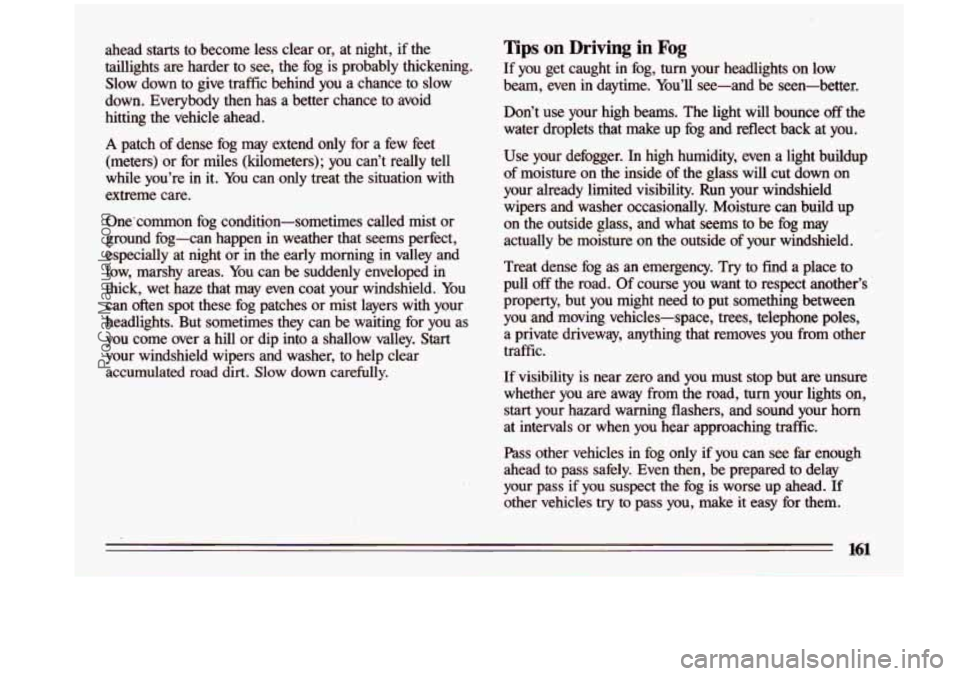
ahead starts to become less clear or, at night, if the
taillights are harder to see, the fog is probably thickening.
Slow down to give traffic behind you a chance to slow
down. Everybody then has a better chance to avoid hitting the vehicle ahead.
A patch of dense fog may extend only for a few feet
(meters) or for miles (kilometers); you can’t really tell
while you’re in it. You can only treat the situation with
extreme care.
One‘common fog condition-sometimes called mist or
ground fog-can happen in weather that seems perfect,
especially at night or
in the early morning in valley and
low, marshy areas. You can be suddenly enveloped in
thick, wet haze that may even coat your windshield. You
can often spot these fog patches or mist layers with your
headlights. But sometimes they can be waiting for you as
you come over a hill or dip into a shallow valley.
Start
your windshield wipers and washer, to help clear
accumulated
road dirt. Slow down carefully.
Tips on Driving in Fog
If you get caught in fog, turn your headlights on low
beam, even in daytime. You’ll see-and be seen-better.
Don’t use your high beams. The light will bounce
off the
water droplets that make up fog and reflect back at you.
Use your defogger. In high humidity, even a light buildup
of moisture on the inside of the glass will cut down on
your already limited visibility. Run your windshield
wipers and washer occasionally. Moisture can build up
on the outside glass, and what seems to be fog .may
actually be moisture on the outside
of your windshield.
Treat dense fog as an emergency.
Try to find a place to
pull off the road. Of course you want to respect another’s
property, but you might need to put something between
you and moving vehicles-space, trees, telephone poles,
a private driveway, anything that removes you from other
traffic.
If visibility is near zero and you must stop but
are unsure
whether you are away from the road, turn your lights on,
start your hazard warning flashers, and sound your horn
at intervals or when you hear approaching traffic.
Pass other vehicles in fog only if you can see far enough
ahead to pass safely. Even then, be prepared
to delay
your pass if you suspect the fog is worse up ahead.
If
other vehicles try to pass you, make it easy for them.
161
ProCarManuals.com
Page 164 of 324
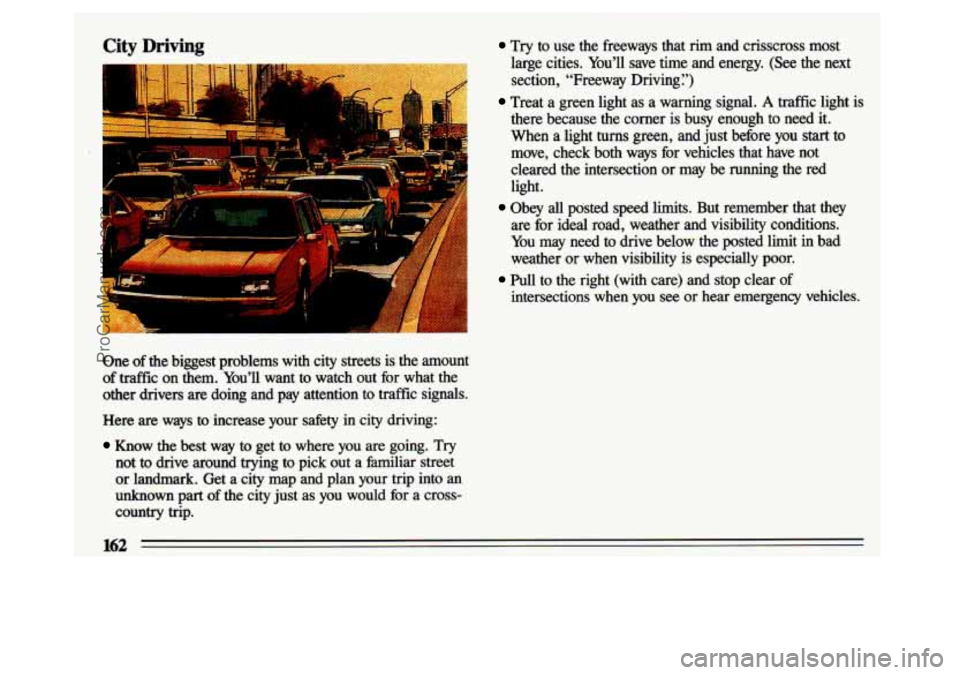
3ty
r--
i. _-- 4 ?I i
Try to use the freeways that rim and crisscross most
large cities. You’ll save time and energy. (See the next
section, “Freeway Driving?)
Treat a green light as a warning signal. A traffic light is
there because the corner is busy enough to need it.
When a light
turns green, and just before you start to
move, check both ways for vehicles that have not
cleared the intersection or may
be running the red
light.
Obey all posted speed limits. But remember that they are for ideal road, weather and visibility conditions.
You may need
to drive below the posted limit in bad
weather
or when visibility is especially poor.
Pull to the right (with care) and stop clear of
intersections when you see or hear emergency vehicles.
One of
the biggest problems with city streets is the amount
of traffic on them. You’ll want to watch out for what the
other drivers
are doing and pay attention to traffic signals.
Here
are ways to increase your safety in city driving:
Know the best way to get to where you are going. Try
not to drive around trying to pick out a familiar street
or landmark. Get a city map and plan your trip into an
unknown part of the city just as you would for a cross-
country trip.
162
ProCarManuals.com
Page 165 of 324

Freeway Driving
.. . . :
Mile for mile, freeways (also called thruways, parkways,
expressways, turnpikes, or superhighways) are the safest
of all roads. But they have their own special rules.
The most important advice on freeway driving is: Keep
up with traffic and keep to the right. Drive at the same speed most
of the other drivers are driving. Too-fast or
too-slow driving breaks a smooth traffic flow. Treat the
left lane on a freeway as a passing lane.
Entering the Freeway
At the entrance there is usually a ramp that leads to the
freeway. If you have a clear view of the freeway as you
drive along the entrance ramp, you should begin to check
traffic. Try to determine where you expect to blend with
the flow. If traffic is light, you may have no problem. But
if it is heavy, find a gap as you move along the entering
lane and time your approach. Try to merge into the gap
at close to the prevailing speed. Switch on your
turn
signal, check your rearvidw mirrors as you move along,
and glance over your shoulder as often as necessary. Try
to blend smoothly with the traffic flow.
Driving on the Freeway
Once you are on the freeway, adjust your speed to the
posted limit or to the prevailing rate if it’s slower. Stay in
the right lane unless you want to pass.
If you are on a
two-lane freeway, treat the right lane as the slow lane
and
the left lane as the passing lane.
If you are on a three-lane freeway, treat the right lane as
the slower-speed through lane, the middle lane as the
higher-speed through lane, and the left lane as the
passing lane.
Before changing lanes, check your rearview mirrors.
Then use your turn signal. Just before you leave the lane, glance quickly over your shoulder to
make sure there
isn’t another vehicle in your “blind” spot.
163
ProCarManuals.com
Page 166 of 324
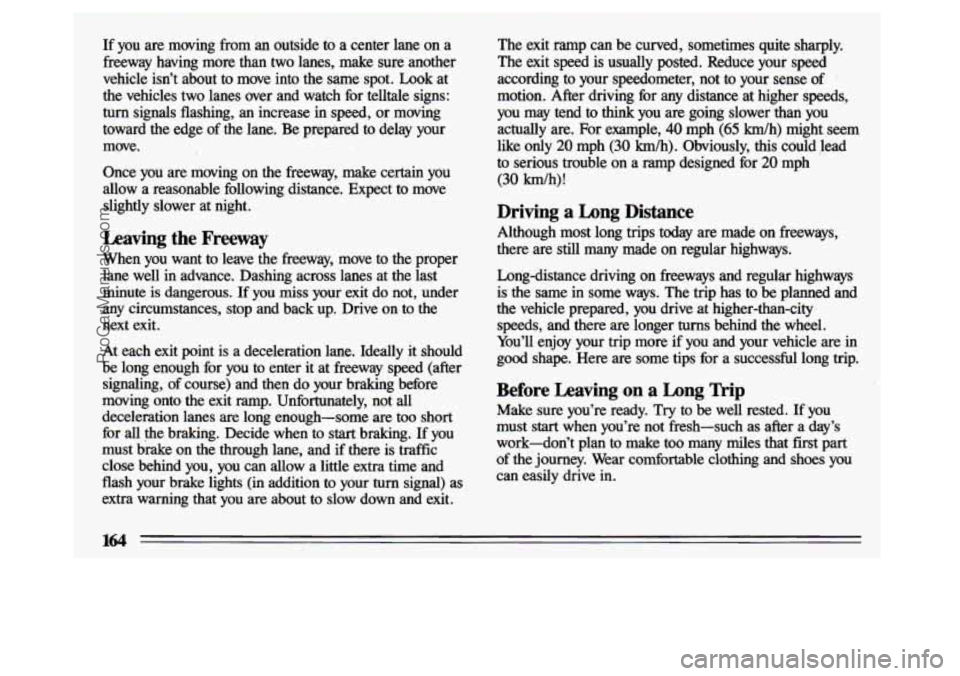
If you are moving from an outside to a center lane on a
freeway, having more than two lanes, make sure another
vehicle isn’t about
to move into the same spot. Look at
the vehicles two lanes over and watch for telltale signs:
turn signals flashing, an increase in speed, or moving
toward the edge of the lane. Be prepared to delay your
move.
Once you are moving on the freeway, make certain you
allow a reasonable following distance. Expect to move slightly slower at night.
Leaving the Freeway
When you want to-leave the freeway, move to the proper
lane well in advance. Dashing across lanes at the last
minute is dangerous.
If you miss your exit do not, under
any circumstances, stop and back up. Drive
on to the
next exit.
At each exit point is a deceleration lane. Ideally it should
be long enough for you to enter it at freeway speed (after
signaling, of course) and then do your braking before
moving onto the exit ramp. Unfortunately, not all
deceleration lanes are long enough-some are too short
for
all the braking. Decide when to start braking. If you
must bkke on the through lane, and if there is traffic
close behind you, you can allow a little extra time and
flash your brake lights (in addition to your
turn signal) as
extra warning that you are about to slow down and exit. The ,exit ramp can be curved, sometimes quite sharply.
The exit
speed is usually posted. Reduce your speed
according to your speedometer, not to your sense of
motion. After driving for any distance at higher speeds,
you may tend to
think you are going slower than you
actually
are. For example, 40 mph (65 km/h) might. seem
like only
20 mph (30 ludh). Obviously, this could lead
to serious trouble on a ramp designed for
20 mph
(30 ludh)!
Driving a Long Distance
Although most long trips today are made on freeways,
there are still many made on regular highways.
Long-distance driving on freeways and regular highways
is
the same in some ways. The trip has to be planned and
the vehicle prepared, you drive at higher-than-city
speeds, and there are longer turns behind the wheel.
You’ll enjoy your trip more if you and your vehicle are in
good shape. Here are some tips for a successful long trip.
Before Leaving on a Long Trip
Make sure you’re ready. Try to be well rested. If you
must start when you’re not fresh-such as after a day’s
work-don’t plan to make too many miles that first part
of the journey. Wear comfortable clothing and shoes you
can easily drive in.
164
ProCarManuals.com
Page 167 of 324
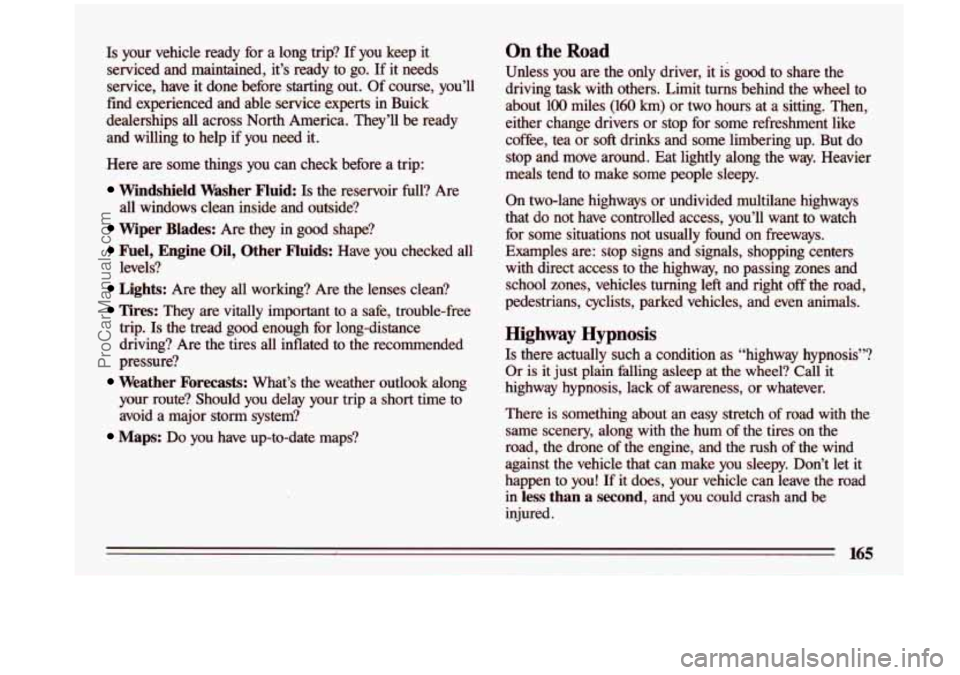
Is your vehicle ready for a long trip? If you keep it
serviced and maintained, it’s ready to go. If it needs
service, have it done before starting out.
Of course, you’ll
find experienced and able service experts in Buick
dealerships
all across North America. They’ll be ready
and willing to help if you need it.
Here are some things you can check before
a trip:
Windshield Washer Fluid: Is the reservoir full? Are
all windows clean inside and outside?
Wiper Blades: Are they in good shape?
hel, Engine Oil, Other Fluids: Have you checked all
Lights: Are they all working? Are the lenses clean?
Tires: They are vitally important to a safe, trouble-free
trip.
Is the tread good enough for long-distance
driving? Are the tires all inflated to the recommended
pressure?
Weather Forecasts: What’s the weather outlook along
your route? Should you delay your trip a short time to
avoid a major storm system?
levels?
Maps: Do you have up-to-date maps?
On the Road
Unless you
are the only driver, it is good to share the
driving task with others. Limit
turns behind the wheel to
about
100 miles (160 km) or two hours at a sitting. Then,
either change drivers or stop for some refreshment like
coffee, tea or
sol3 drinks and some limbering up. But do
stop and move around. Eat lightly along the way. Heavier
meals tend
to make some people sleepy.
On two-lane highways or undivided multilane highways
that do not have controlled access, you’ll want to watch for some situations not usually found on freeways.
Examples are: stop signs and signals, shopping centers
with direct access to the highway, no passing zones and school zones, vehicles turning left and right
off the road,
pedestrians, cyclists, parked vehicles, and even animals.
Highway Hypnosis
Is there actually such a condition as “highway hypnosis”?
Or is it just plain falling asleep at the .wheel? Call it
highway hypnosis, lack of awareness, or whatever.
There is something about an easy stretch
of road with the
same scenery, along with the hum
of the tires on the
road, the drone
of the engine, and the rush of the wind
against the vehicle that can make you sleepy. Don’t let it \
happen to you!
If it does, your vehicle can leave the road
in
less than a second, and you could crash and be
injured.
165
ProCarManuals.com
Page 173 of 324

Winter Driving
Here are some tips for winter driving:
Have your Buick in good shape for winter. Be sure
your engine coolant mix is correct.
Snow tires can help in loose snow, but they may give
you less traction on ice than regular tires. If you do not
expect to
be driving in deep snow, but may have to
travel over ice,
you may not want to switch to snow
tires at all.
vehicle.
You may want to put winter emergency supplies in your
Include an ice scraper, a small brush or broom, a
supply of windshield washer fluid, a rag, some winter
outer clothing, a
small shovel, a flashlight, a red cloth,
and a couple of reflective warning triangles.
And, if
you will
be driving under severe conditions, include a
small bag of sand, a piece of old carpet or a couple of
burlap bags to help provide traction. Be sure you
properly secure these items in your vehicle.
171
ProCarManuals.com
Page 176 of 324
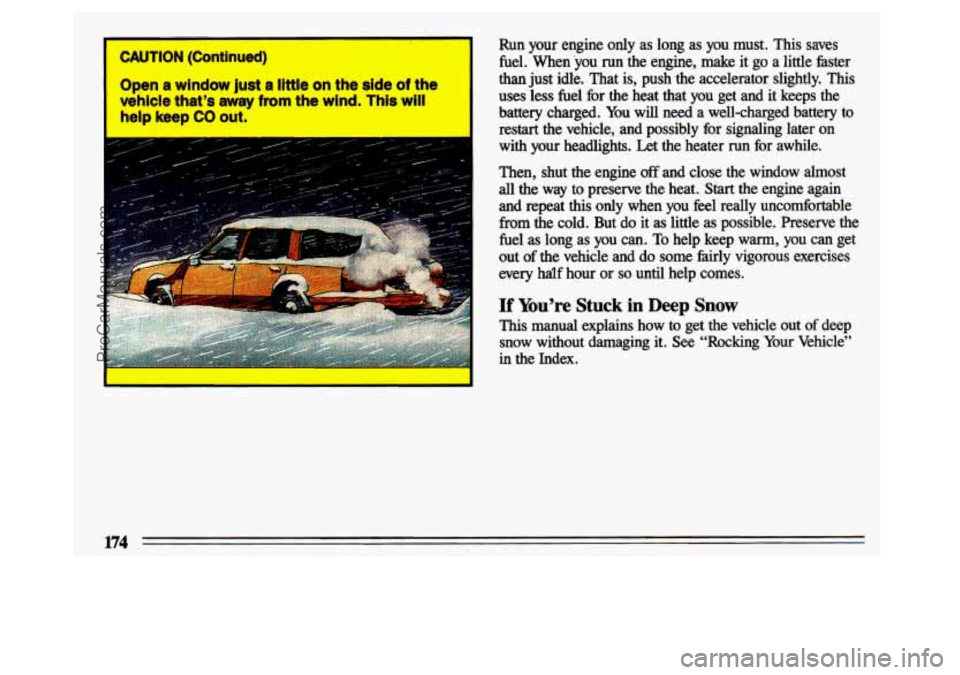
~ CAUTION (Contlnued)
1 Opien a wlndow Just a llttle on the side of the
vehlcie that’s
away fmm the wind. Thls will
help keep CO out.
I
Run your engine only as long as you must. This saves
fuel. When you run the engine, make it go a little faster
than just idle. That is, push the accelerator slightly. This
uses less
fuel for the heat that you get and it keeps the
battery charged. You
will need a well-charged battery to
restart
the vehicle, and possibly for signaling later on
with your headlights. Let the heater run for awhile.
Then, shut the engine
off and close the window almost
all the way to preserve the heat. Start the engine again
and repeat
this only when you feel really uncomfortable
from the cold. But do it as little as possible. Preserve the
fuel
as long as you can. To help keep warm, you can get
out
of the vehicle and do some fhirly vigorous exercises
every half hour or
so until help comes.
If You’re Stuck in Deep Snow
This manual explains how to get the vehicle out of deep
snow without damaging
it. See “Rocking Your Vehicle”
in the Index.
174
ProCarManuals.com
Page 181 of 324
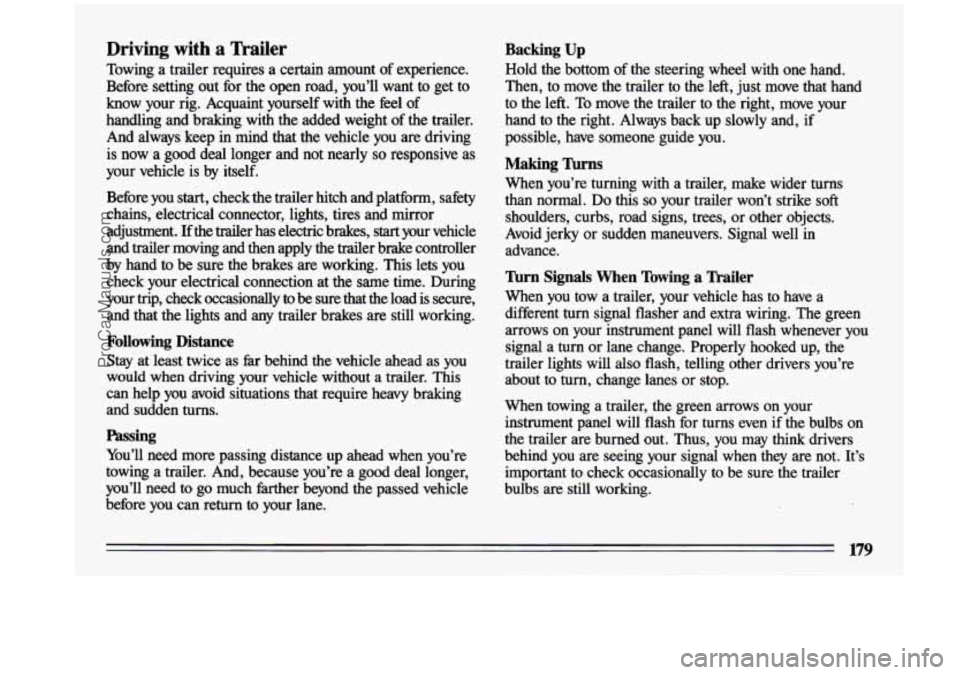
Driving with a Trailer
Towing a trailer requires a certain amount of experience.
Before setting out for the open road, you’ll want to get t\
o
know your rig. Acquaint yourself with the
feel of
handling and braking with the added weight of the trailer.
And always keep in mind that the vehicle you
are driving
is now a good deal longer and not nearly
so responsive as
your vehicle is by itself.
Before you
start, check the trailer hitch and platform, safety
chains, electrical connector, lights, tires and mirror
adjustment. If the trailer has electric brakes,
start your vehicle
and trailer moving and then apply the trailer brake controller \
by hand to be sure the brakes
are working. This lets you
check your electrical connection at the same time. During
your trip, check occasionally
to be sure that the load is secure,
and that the lights and any trailer brakes are still working.
Following Distance
Stay at least twice as fit, behind the vehicle ahead as you
would when driving your vehicle without a trailer. This
can help you avoid situations that require heavy braking
and sudden turns.
Passing
You’ll need more passing distance up ahead when you’re
towing
a trailer. And, because you’re a good deal longer,
you’ll
need to go much farther beyond the passed vehicle
before you can return to your lane.
Backing Up
Hold the bottom of the steering wheel with one hand.
Then, to move the trailer to the left, just move that hand
to the left.
To move the trailer to the right, move your
hand to the right. Always back up slowly and, if
possible, have someone guide you.
Making nrns
When you’re turning with a trailer, make wider turns
than normal.
Do this so your trailer won’t strike soft
shoulders, curbs, road signs, trees, or other objects.
Avoid jerky or sudden maneuvers. Signal well in
advance.
Turn Signals When Towing a Mler
When you tow a trailer, your vehicle has to have a
different turn signal flasher and extra wiring. The green arrows on your instrument panel will flash whenever you
signal a turn or lane change. Properly hooked up, the
trailer lights will also flash, telling other drivers you’re \
about to turn, change lanes or stop.
When towing a trailer, the green arrows on your instrument panel will flash for turns even if the bulbs on
the trailer are burned out. Thus, you may think drivers
behind you are seeing your signal when they are not. It’s
important to check occasionally to be sure the trailer
bulbs are still working.
179
ProCarManuals.com